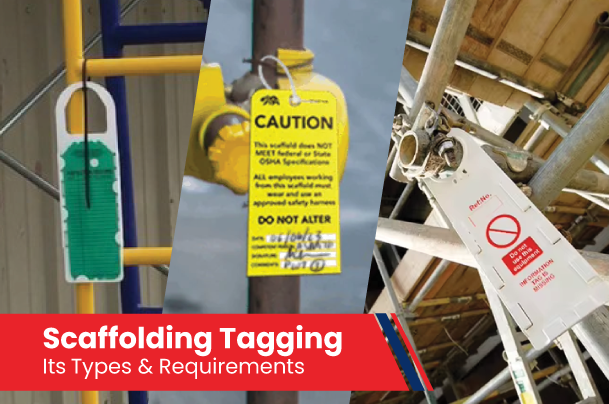
In today’s world, scaffolding is useful for many construction projects. This structure allows workers to perform tasks at different heights. But, before workers start using the structure, they should know whether it’s safe to use. Here’s when tagging plays a vital role. Besides ensuring safety, the tags also ensure compliance. Don’t know the meaning of every type of colored tag? Scroll ahead to know more about scaffolding tagging and its types.
What is Scaffold Tagging?
Hanging tags can convey more about the scaffold’s condition. As these are visual indicators, they help to confirm whether the scaffolds are safe to use. Ensuring safety at the site is further presented by labeling the scaffold. Apart from everything else, such tags also indicate that the components meet regulatory standards. This, in turn, makes workers alert to use the scaffolding at different heights. At some construction sites, scaffolding tags may also indicate whether people have inspected the structure regularly. To enable workers to use the structure safely, the tags may also include instructions for assembling or dismantling.
Now, let’s check out whether there’s always a need for scaffolding tagging.
Does OSHA Require Scaffolding to be Tagged?
In the UK, tagging scaffold components is not considered essential in the UK. Hence, contractors don’t use the tags at the sites. However, when tags are hung on different scaffolding parts, they can communicate the risk of using the structure. By this way, workers simply have to observe the scaffold tag before use. They don’t have to speak with someone to check if the structure has been inspected.
Now, OSHA does have requirements related to tagging. This will ensure safety at the construction site. Let’s check out some points regarding OSHA’s requirements.
OSHA’s Requirements for Scaffolding Tagging
Identification
OSHA regulations require that bracing, platforms, and frames have to be marked. The scaffolding tag system will indicate the overall capacity of the structure. It also will enable workers to assemble the scaffolding correctly and use it within the load limits.
Inspection Tags
Before workers start using the scaffolding, an experienced individual should inspect the components. A bit later, the individual has to also check the structural integrity after an unexpected event. Once he finishes the inspection, he should state the date of inspection along with scaffolding tagging guidelines.
Documentation
Soon after inspecting the scaffold, professionals maintain a record of the inspection activities. This will represent compliance with OSHA standards while the project progresses. On the other hand, training has to be given to workers to make them aware about different procedures. Professionals have to let workers know about the steps for assembling and disassembling the structure.
What Do The Scaffold Tags Signify?
Tags are easily noticeable when you observe scaffolds. Here’s what every tag means under the scaffolding tag system.
Standard Tags
Such tags follow a standard color-coding system and indicate the status. Workers usually hang these tags at places which are easily visible.
Green Tags
The scaffold is safe to use if there’s a green tag. Moreover, the tags signify that the structure meets the safety standards and is strong for usage.
Yellow Tags
Usually, scaffolds with yellow tags signify that they still need repairs after inspection. The information on the tag can also present the facts that the structure needs attention. Such tags shouldn’t be removed till the scaffolding tagging is inspected once again.
Red Tags
As soon as the scaffold is erected at the site, it may get damaged due to some reasons. Red tags are therefore attached to the components to denote danger. In fact, such tags present a warning to avoid using the structure till it undergoes repairs.
Blue Tags
At some instances, you may also see blue tags on scaffolds. These indicate that scaffolding is meant for a certain task. It can also show that the scaffold has been configured for a particular project phase. Therefore, contractors can manage scaffolding at different sites when workers carry out different activities.
Black Tags
In some cases, black tags are hung to indicate that it’s time to dismantle the scaffold. Once you observe the tag closely, you may also see the day on which workers have to disassemble the scaffold. Such tags help to ensure that the scaffold is dismantled at the right time.
Where Should Scaffold Tags be Attached to the Scaffold?
In simple terms, scaffolding tagging should be practiced at locations which are easily visible. These locations include the access points near or above the ground level. In case the scaffold has different levels, then placing the tags at the levels can ensure safety of different areas. Moreover, it’s better to place tags when workers are not allowed to use an unsafe structure. These tags are useful especially when workers are completely unaware about safety around the scaffold. But, before hanging the tags, make sure that the tag states the inspection date, inspection results, and load capacity or limit.
Conclusion
Workers have to carry out regular inspections to check the scaffolding tags. While they observe the tags, they should ensure that it depicts precise information. If the tags are missing, then they should hang them immediately. This tip will not only help to stay compliant but also help in communicating the condition effectively. As the scaffold is erected outdoors, the tags should also be made using waterproof material.
Scaffolds Supply
At Scaffolds Supply, we assure you with utmost quality once you start using the scaffold. While we deal in Cuplock, Ringlock and Frame scaffolds, our team can help in shipping them at the construction site. As we understand the need for diverse inventory, we have kept the stock at a yard located in Houston. Over the years, we have also been proud about supplying scaffold components and accessories to different sites worldwide.











Comments are closed